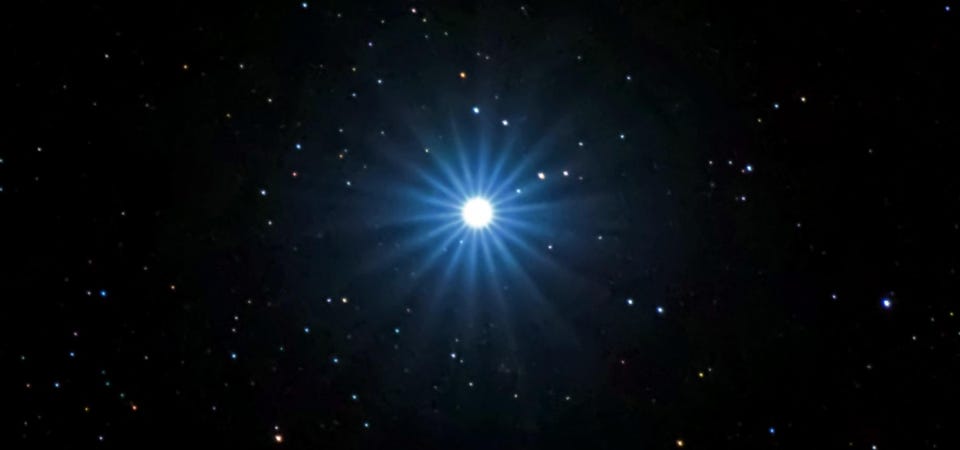What’s The Brightest Star In The Night Sky? How To Find The ‘Rainbow Star’ With Your Naked Eyes


Sirius Brightest star on Night sky, Sirius Star
getty
You thought the brightest star is Polaris, right? Or one of the stars in Orion? Nope! Sirius—the “Dog Star”—never seems to get the recognition it deserves. It’s the brightest star in the night sky by far, shining at a magnitude 1.4. That puts it behind only our Moon, Jupiter and Venus in terms of brightness.
What even fewer people know is that Sirius also shines in all the colors of the rainbow.
Sirius is so bright that it’s sometimes mistaken for a planet. Maybe that’s why it’s often overlooked. Or perhaps it’s because the constellation Sirius is in is rather dim.
Canis Major, visible in right now in both hemispheres, is made up of 10 stars—Adhara, Aludra, Amadioha, Atakoraka, Furud, Mirzam, Muliphein, Sirius, Unurgunite and Wezen—though none are anywhere near as bright as Sirius or the nearby stars of Orion.

The constellation of Canis Major, the large hunting dog of Orion the hunter The binocular open star … [+] cluster Messier 41 is at centre below Sirius The pair of star clusters, M46 and M47, are at left The bright star is of course the Dog Star, Sirius This is a stack of 2 x 2-minute exposures with the 50mm Sigma lens at f/25 and Canon 5D MkII at ISO 1600, plus an additional exposure through the Kenko Softon filter layered in to add the star glows Taken from Quailway Cottage in Arizona, with the Star Adventurer Mini tracker. (Photo by: VW Pics/Universal Images Group via Getty Images)
Universal Images Group via Getty Images
Sirius and Orion: the hunter’s dog
Another reason most people don’t instantly know where Sirius is might be because it trails Orion, surely the most well-known constellation of all. That’s slightly ironic because Sirius is rising underneath the “hunter” right now in the southeast—as seen from the northern hemisphere—as darkness falls.
In Greek mythology, Sirius was associated with the god Orion and was said to be the dog of the hunter—hence its constellation Canis Major translates as “the big dog” and it’s called the “dog star.”

Sirius is always pointed to by Orion’s Belt. Seen here beside the Matterhorn peak, Zermatt, … [+] Switzerland.
getty
How to find Sirius
As night falls you can use the stars of Orion’s Belt to find Sirius. Find the three belt stars —Mintaka, Alnilam and Alnitak—and go down towards the eastern horizon. Sirius is located just to the south of Orion and is the brightest star in that area of the sky. It’s really easy to find.
Sirius is an important star. Just 8.6 light-years from the solar system, it’s part of the fifth closest stellar system to the Sun. A blue-white main sequence star about twice as massive as the Sun, it’s one of the hottest stars in the night sky.

Bright star Sirius in the constellation Canis Major. The astronomical cluster of stars in the … [+] southern hemisphere
getty
Sirius is not one star
However, it’s not actually alone.
Sirius is a binary star, with that blue-white giant star accompanied by a faint white dwarf companion (the leftover remnants of stars similar to our Sun). The two stars revolve around each other every 50 years.
That might seem odd, but up to 85% of stars are in binary systems with some in triple or even higher-multiple systems.

Sirius displays color if you tap a telescope, as photographed by Sirius photographer, meteor … [+] watcher, astronomer and astrophotographer Steve Brown in North Yorkshire, UK.
Steve Brown (used with permission)
Sirius as the ‘rainbow star’
Sirius is also one of the few stars worth putting a telescope on. Not to see its white dwarf companion (you’d need a massive telescope for that), but for its wonderful colors. Stars twinkle because we see their light bent slightly by the turbulent air in our planet’s atmosphere.
The easiest way to see its colors is to focus a telescope on it, then tap the telescope. You’ll get an image like the above, by Sirius photographer and astrophotographer Steve Brown in North Yorkshire, UK, who regularly tweets images of Sirius and uploads astro videos to his YouTube channel.
It’s best done when Sirius is relatively low in the sky. However, because it’s so close and so bright its more intense light is split into a spectrum by Earth’s turbulent atmosphere, so it appears in all the colors of the rainbow when it’s low down. As it rises higher it becomes brighter and whiter.
So go out and find Sirius—the brightest star in the night sky—and you’ll forever look out for it each time you glimpse Orion’s belt.
Wishing you clear skies and wide eyes.
